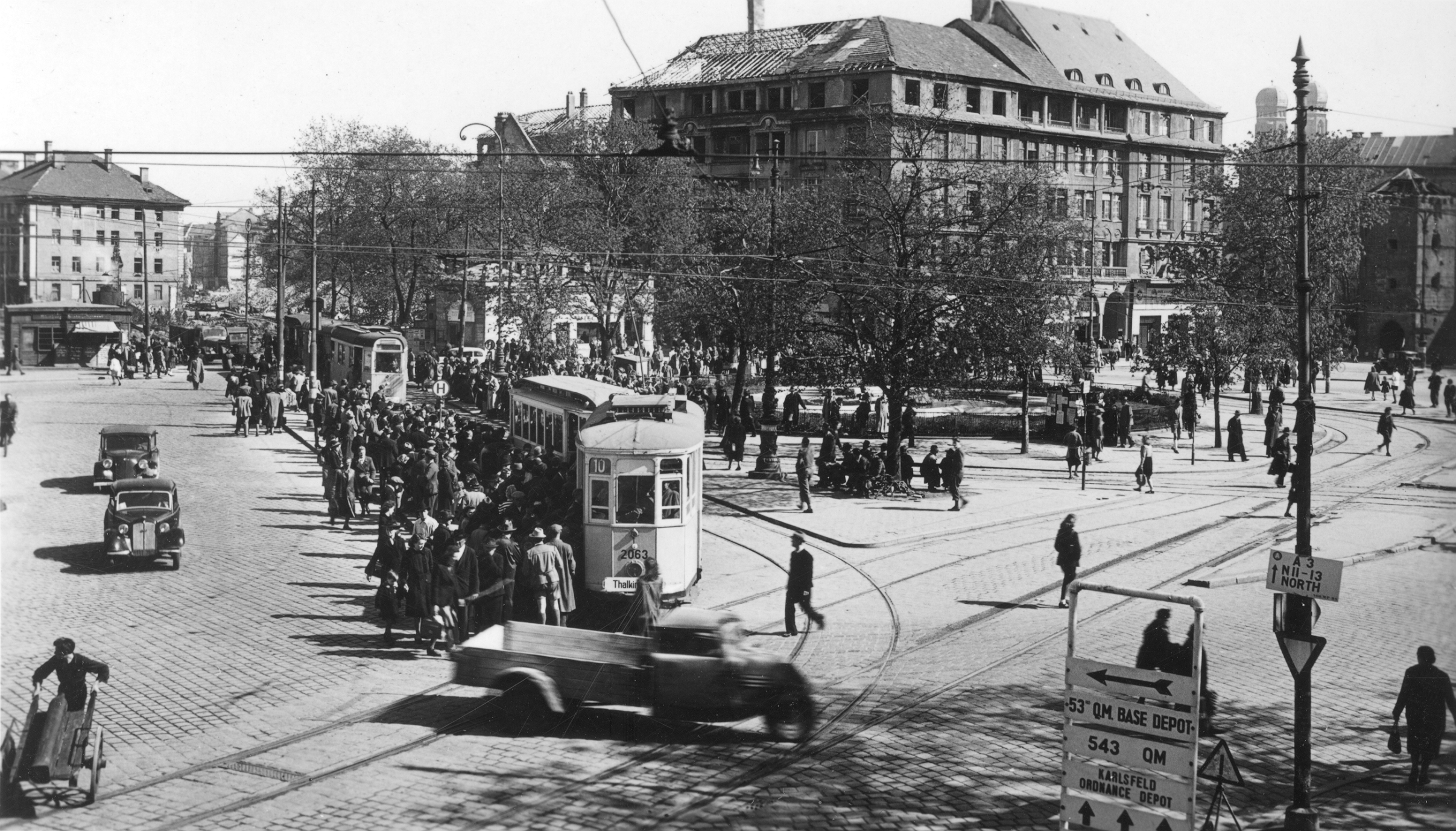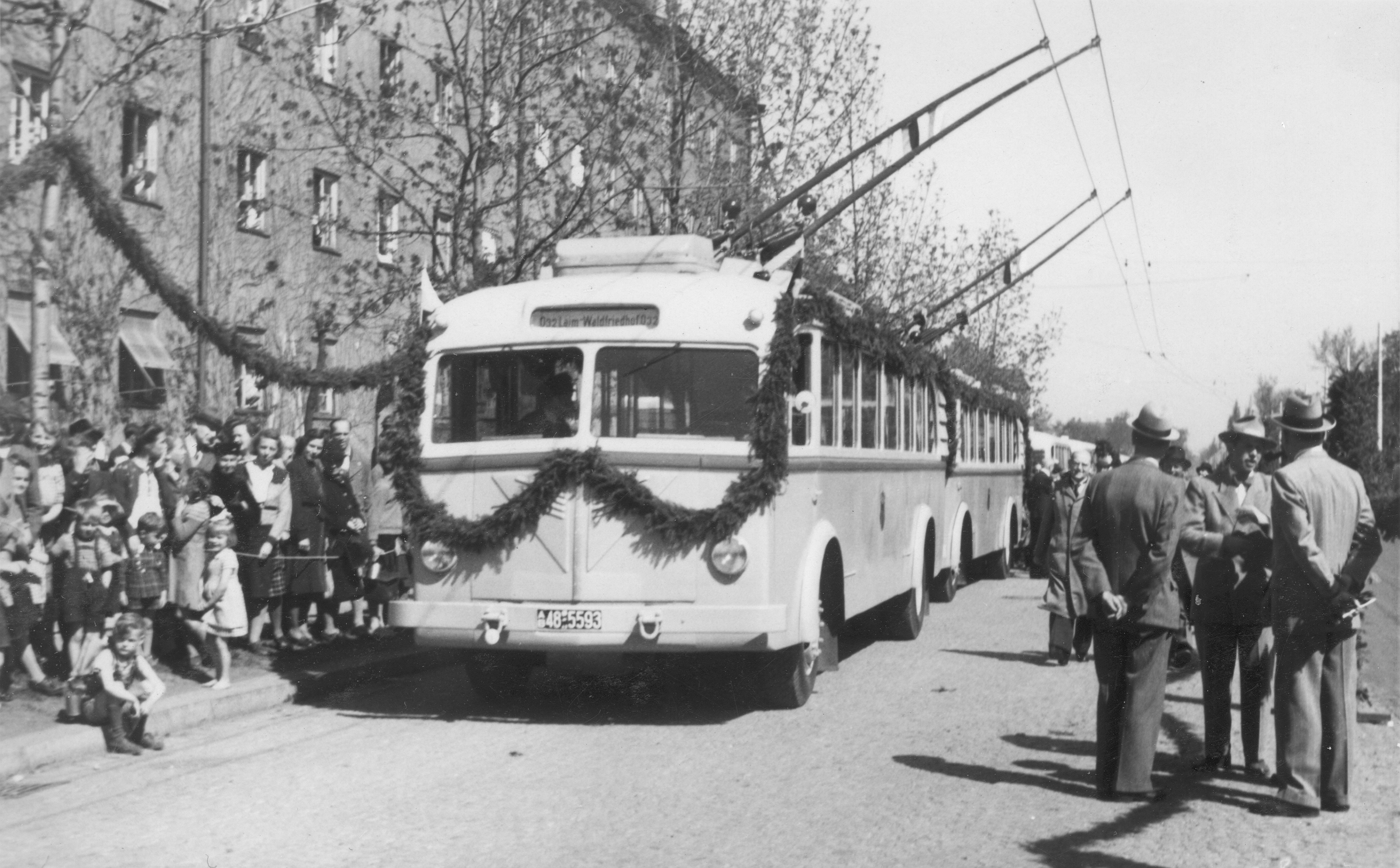1945 – 1956: Time of reconstruction

Only with difficulty did public life in Munich get going again. The American military government under city commander Eugene Keller immediately removed all Nazi officials from their posts and filled the vacant positions with proven Democrats. Factory director Josef Kellner also resigned from office, the management of the distressed factory was transferred to his predecessor senior building director Otto Scholler. After the entire tram traffic had initially rested four weeks, because the driver was used for the removal of debris, went from May 22, 1945 gradually single legs back into operation. The repair of the war damage with repair of the operating facilities and the car park were the most urgent tasks.
The remaining drivers and workshop personnel were clearly overaged; until the currency reform an annual fluctuation of up to one third of the workforce took place. Of the existing in 1938 444 power and 516 sidecar 196 motor and 186 sidecar were totally destroyed during the war. A considerable part had been damaged or in need of repair so far that by July 1945 only 170 motor vehicles and 280 side-cars could be made to work in a makeshift manner. In addition, 116 of originally 161 vehicles from various cities in Germany and abroad, who had come to Munich during the war as part of the Reichsleistungsgesetz, were added.
It was urgently necessary to procure a powerful, modern vehicle to handle Munich's enormous traffic problems. But first in 1946 vehicles of the J-series were ordered again. Slowly the most damaged streets of the city could be made accessible again, starting from October 7, 1946, line 6 could again run through the Ludwig and Leopoldstrasse, this important north / south axis was without tram since July 12, 1944 , On February 16, 1947, the "classical route" Stachus - Marienplatz - Isartor was reopened for the lines 1, 9 and 19.
On April 1, 1947 Dr.-Ing. Julius Ulsamer the deserved senior building director Otto Scholler to the post as director of the public transport. He was instrumental in the development of a modern, three-axle large-capacity car tailored to Munich conditions. Not for nothing he is considered the "father" of the now legendary wagon type "M". Although the currency reform initially deprived the transport companies of their assets, as a result the personnel and material shortage improved considerably, as the D-Mark finally provided a valuable means of payment with high purchasing power. Munich even received a new means of transport! In the west of the city was opened on 28 April 1948 for the first time a trolleybus line on the route Waldfriedhof - Laim, which will be extended in the coming years at both endpoints, will never go beyond the status of an appendage. It remained a hull operation, which is finally given up on April 28, 1966.
On January 1, 1949, 441 cars were used on Munich's tracks. The return of almost all Italian cars, enforced by the American military government, further aggravated the fleet situation. Only twelve motor coaches originating from Milan remained in Munich after they had to be bought again. These railcars were under the type designation H until 1958 in use. Only through the ongoing delivery of brand new KSW was this setback gradually offset. On 1 January 1950, the public transport companies were able to operate 19 tram lines. Every day, the cars covered 106,000 km. The staff situation relaxed. 2725 car drivers, conductors and inspectors were in active driving, to 1700 workers were employed in the various workshops. But of the 122 kilometers of the Munich tram track network, 27.7% were over 30 years old. 19% of the rail network had traveled so far that the condition was classified as hazardous.
On January 2, 1950, the wagon factory Rathgeber delivered the first prototypes, which began the era of three-axle large-capacity cars of the type "Munich". This type of car was further developed in the following years and was to be the dominant and typical tram vehicle in Munich for five decades.
The re-commissioning of the prewar network was almost completed this year; As the last of the previously closed tram routes in the city center, the route via Gasteig and Innere Wiener Straße was reopened on 7 April 1950. Senior Construction Director Ulsamer left on 15 June 1950, the public transport and moved to the Cologne wagon factory West Waggon. Now Dr. Fritz Baumeister the management of the transport companies. He led the fate of the tram for fifteen years and succeeded in repelling all attacks by opponents of this means of transport. Under his direction, the course was set for the expansion and modernization of the tram. It was only in 1964, towards the end of his term of office, that a political turnaround was called for the construction of a subway system.
On 21 October 1951, Stadtwerke celebrated the 75th anniversary of the Munich tram. All urban means of transport on that day with festoon decorations and pennants.
In the meantime, the city and public transport authorities were working on a general traffic route plan, which was to take into account the changed conditions of a city, which was increasingly determined by motor traffic, for further expansion planning. At its center was a simplified tram network, which was to be largely supplemented by bus lines. The majority of the required new lines in the outer quarters was actually realized in the 1960s.
On January 7, 1955 reversed on the line 5 with a festively decorated A-railcar last time a tram car with the much mocked rod collector. With great sympathy, the people of Munich parted wistfully farewell to the "Stangerl", which had accompanied their electric tram for almost 60 years and often enough had also slowed down.
Opening of the trolley line at Laim at 28th of April in 1948. Archiv MVG
By missing spare parts only some cars was operating the tramway traffic. A tramway car imported from Milan with hundreds of peaple trying to enter this car on 22nd of April 1947. Archiv MVG
Since1950 new constructed three axel tramway cars was opertaing in the Munich tramway network like car # 764 typ M at Leonrodplatz.
Archiv FMTM e.V.



The increasing car traffic slowly grew into traffic chaos and began to show effects on the tram. At Stachus, during peak hours, and especially in the evenings, the wagon trains made convolutions from the individual directions into convoys, and it often took ten or more minutes before a wagon train could jerkily cross the square. In the emergency one tried starting from the 5. December 1955 city bus Eillinien to the reinforcement and relief of the Trambahn to use, which were however hardly accepted by the population.
Translated by Google
Weiter: 1956 – 1964: Ausbau der Trambahn und Verkehrschaos
Autor: Klaus Onnich FMTM eV., Leiter Fahrdienst Bus Ost und
stv. Betriebsleiter BO Kraft der Stadtwerke München GmbH
Stachus: businest traffic junction place of Europe at this time in 1955. Archiv MVG
